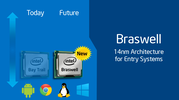Intel Celeron N3060 vs Intel Celeron N5100
Intel Celeron N3060
► remove from comparison
The Intel Celeron N3060 is a low-end dual-core SoC for notebooks, which has been presented in April 2015. It is clocked at 1.6 - 2.48 GHz and part of the Braswell platform. Thanks to its new 14 nanometer low-power process (P1273) with tri-gate transistors, energy efficiency has been significantly improved compared to its predecessor architecture Bay Trail (e.g. Celeron N2840). The N3060 is successor (refresh) to the Celeron N3050 and compared to it it offers a improved Turbo clock rate (2.48 vs 2.1 GHZ).
In addition to the CPU cores, the SoC offers a DirectX 11.2-capable GPU as well as a DDR3L Memory Controller (2x 64 bit, 25.6 GB/s).
Architecture
The processor cores are based on the Airmont architecture, which is basically a slightly modified shrink of the previous Silvermont core. While performance per clock has not been improved, the more efficient 14 nm process leads to a better utilization of the CPU Burst (alias Turbo Boost) and a therefore somewhat higher overall performance.
Performance
Depending on the cooling of the SoC, the Boost clock rate of 2.48 can be held for longer periods and therefore leading to a faster performance as the older Celeron N3050 that can only reach 2.16 GHz. Using Windows, the CPU is adequate for simple everyday tasks such as light Internet browsing or office applications, but not for complex software or modern games.
Graphics
The HD Graphics 400 (Braswell) is based on the Intel Gen8 architecture, which supports DirectX 11.2 and is also found in the Broadwell series (e.g. HD Graphics 5300). With 12 EUs (Execution Units) and a clock speed of up to 600 MHz, the GPU is almost twice as fast as the HD Graphics (Bay Trail), but still not powerful enough to handle modern 3D games. The GPU also supports 4K/H.265 video acceleration. Although featuring a different name, the GPU was not changed from the N3050 (named HD Graphics alone).
Power Consumption
The entire SoC is rated at an TDP of 6 watts (SDP 4 watts). Thus, the chip can be cooled passively.
Intel Celeron N5100
► remove from comparison
The Intel Celeron N5100 is a quad-core SoC of the Jasper Lake series that is primarily intended for inexpensive notebooks and was announced in early 2021. The four Tremont CPU cores clock between 1.1 and 2.8 GHz (single core Burst) and offer no HyperThreading (SMT). The N5100 uses 1.5 MB L2 and 4 MB L3 cache. The chip is manufactured in 10nm at Intel (most likely in the same process as Ice Lake).
Architecture
The processor architecture is called Tremont and a complete redesign compared to the old Golmont Plus cores in the predecessor. According to Intel, the single thread performance of a core could be improved by 30% on average (10 - 80% in all tests of SPECint and SPECfp).
Features
In addition to the quad-core CPU block, the SoC integrates a 24 EU Intel UHD Graphics GPU clocked from 350 - 800 MHz and a LPDDR4(x) dual channel memory controller (up to 16 GB and 2933 MHz). The chip now also partly integrates Wi-Fi 6 (Gig+), 8 PCIe 3.0 lanes, 14 USB 2.0/ 3.2 ports and two SATA 6.0 ports. The package got bigger and measures 35 x 24 mm (compared to 25 x 24 mm for the N5030 e.g.). The SoC is directly soldered to the mainboard (BGA) and can't be easily replaced.
Performance
While we have not tested a single system powered by the N5100 as of August 2023, it's safe to expect the chip to be 10% to 20% slower than the N6000, as far as multi-thread performance is concerned. In other words, this is a fairly slow processor that is unlikely to make anybody happy.
Power Consumption
Like most other N-class Intel processors, this Celeron has a 6 W default TDP (also known as the long-term power limit). This is rather low; a small metal plate is all it takes to dissipate heat generated by such a CPU.
The Celeron N5100 is manufactured on Intel's first-generation or second-generation [no exact data available] 10 nm process for average, as of early 2023, energy efficiency.
| Model | Intel Celeron N3060 | Intel Celeron N5100 | ||||||||||||||||||||||||||||||||||||||||||||||||
| Series | Intel Celeron | Intel Jasper Lake | ||||||||||||||||||||||||||||||||||||||||||||||||
| Codename | Braswell | Jasper Lake | ||||||||||||||||||||||||||||||||||||||||||||||||
| Series: Jasper Lake Jasper Lake |
|
| ||||||||||||||||||||||||||||||||||||||||||||||||
| Clock | 1600 - 2480 MHz | 1100 - 2800 MHz | ||||||||||||||||||||||||||||||||||||||||||||||||
| L2 Cache | 2 MB | 1.5 MB | ||||||||||||||||||||||||||||||||||||||||||||||||
| Cores / Threads | 2 / 2 | 4 / 4 | ||||||||||||||||||||||||||||||||||||||||||||||||
| TDP | 6 Watt | 6 Watt | ||||||||||||||||||||||||||||||||||||||||||||||||
| Technology | 14 nm | 10 nm | ||||||||||||||||||||||||||||||||||||||||||||||||
| max. Temp. | 90 °C | 105 °C | ||||||||||||||||||||||||||||||||||||||||||||||||
| Socket | FCBGA1170 | BGA1338 | ||||||||||||||||||||||||||||||||||||||||||||||||
| Features | Intel HD Graphics 400 (Braswell, 12 EUs, 320 - 700 MHz), Wireless Display, Quick Sync, AES-NI, max. 8 GB Dual-Channel DDR3L-1600 (25,6 GB/s), 5x USB 3.0, 4x PCIe 2.0, 2x SATA 6.0 Gbit/s | DDR4-2933/LPDDR4x-2933 RAM, PCIe 3, GNA, MMX, SSE, SSE2, SSE3, SSSE3, SSE4.1, SSE4.2, VMX, SMEP, SMAP, EIST, TM1, TM2, Turbo, AES-NI, RDRAND, RDSEED, SHA | ||||||||||||||||||||||||||||||||||||||||||||||||
| iGPU | Intel HD Graphics 400 (Braswell) (320 - 700 MHz) | Intel UHD Graphics (Jasper Lake 24 EU) (350 - 800 MHz) | ||||||||||||||||||||||||||||||||||||||||||||||||
| Architecture | x86 | x86 | ||||||||||||||||||||||||||||||||||||||||||||||||
| $107 U.S. | ||||||||||||||||||||||||||||||||||||||||||||||||||
| Announced | ||||||||||||||||||||||||||||||||||||||||||||||||||
| Manufacturer | ark.intel.com | ark.intel.com | ||||||||||||||||||||||||||||||||||||||||||||||||
| L3 Cache | 4 MB |


 Deutsch
Deutsch English
English Español
Español Français
Français Italiano
Italiano Nederlands
Nederlands Polski
Polski Português
Português Русский
Русский Türkçe
Türkçe Svenska
Svenska Chinese
Chinese Magyar
Magyar
